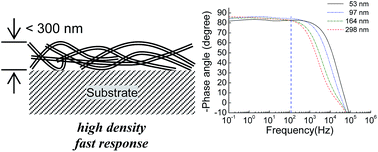2.5 V compact supercapacitors based on ultrathin carbon nanotube films for AC line filtering†
Abstract
A high volumetric energy density, and hence compactness, is an essential property for the supercapacitors needed to replace the bulky aluminum electrolytic capacitors currently used for alternating current (AC) line filtering. In this paper, we demonstrate the fabrication of AC-line-filtering supercapacitors with unprecedentedly high volumetric energy densities (Evol ≈ 4.1 mW h cc−1 at 120 Hz). This high density is achieved by using ultrathin and dense carbon nanotube (CNT) films as electrodes (t ≈ 300 nm, d ≈ 1.1 g cc−1). Importantly, the mesopores and short pore length of the ultrathin films enable sufficiently fast electrolyte ion movement, even with organic electrolytes, for AC line filtering (impedance phase angle, ϕ ≈ −82.2° at 120 Hz). The use of organic electrolytes extends the operating voltage window (V = 2.5 V), and therefore significantly increases the energy density (Evol ∝ V2). Moreover, we show that a gold insertion layer provides the excellent interfacial qualities between the CNTs and aluminum current collector that are required for fast-response applications. Our findings may greatly advance supercapacitor research and technology for emerging high-frequency applications.


 Please wait while we load your content...
Please wait while we load your content...